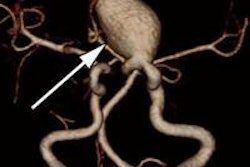However, the MDCT techniques remain limited by suboptimal image postprocessing, particularly for bone removal and the display of distal vessel segments in the presence of vascular calcification.
Recently introduced dual-energy CT (DECT) methods may present an attractive alternative to conventional bone subtraction techniques, according to Shota Yamamoto, Dr. Stefan Ruehm, and colleagues from the University of California, Los Angeles.
In their study, 20 patients (mean age, 73) with known or suspected peripheral artery disease underwent peripheral artery CT angiography using a dual-energy CT scanner (Somatom Definition, Siemens Healthcare, Malvern, PA). Merged datasets enabled the evaluation of both DECT and MDCT images.
Dual-energy bone subtraction (DEBS) delivered far superior vessel visibility to manual bone subtraction (MBS) (2.74 DEBS versus 2.56 MBS, p = 0.011), the authors reported. At dual-energy bone subtraction, only five of 558 nonoccluded vessel segments (0.89%) could not be visualized due to bone remnants, while 7.5% of segments at manual bone subtraction were obscured by remnants (7.5%), Yamamoto told AuntMinnie.com.
Software refinements are needed to minimize vessel alterations in areas of calcified plaque. Once completed, however, "this would aid in a much quicker and accurate diagnosis of peripheral arterial diseases by radiologists, and the images can be produced by anyone," Yamamoto said.



















